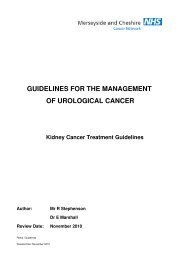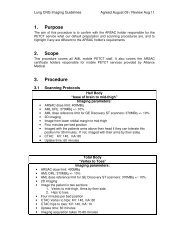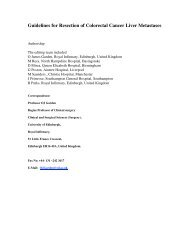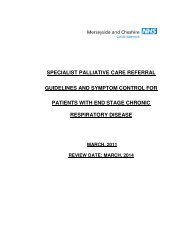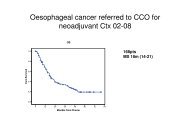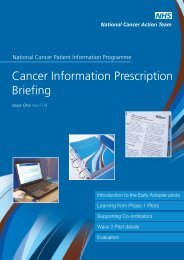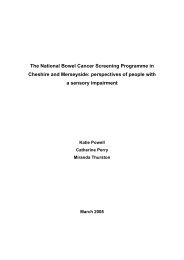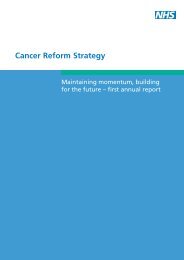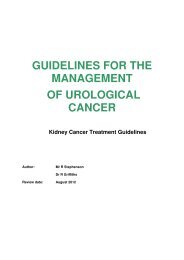Cancer Reform Strategy - NHS Cancer Screening Programmes
Cancer Reform Strategy - NHS Cancer Screening Programmes
Cancer Reform Strategy - NHS Cancer Screening Programmes
- No tags were found...
Create successful ePaper yourself
Turn your PDF publications into a flip-book with our unique Google optimized e-Paper software.
CHAPTER 3: DIAGNOSING CANCER EARLIER 47increase in the workload of the programme,which has only been possible because of newworking practices and the dedication ofscreening staff (see chapter 11).3.19 Our first priority is to maintain this excellentrecord. To do this it is essential that the intervalbetween screens (the round length) ismaintained at three years. PCTs will need toinvest more in breast screening to ensurea three year round length because ofincreasing numbers of women from the‘baby boomer’ generation becoming eligiblefor breast screening. The National <strong>Cancer</strong>Director wrote to SHA Chief Executives inFebruary 2007 alerting them to these challenges.3.20 We now want to extend the programmeso that more women benefit and save evenmore lives. At present, women are invited forscreening seven times at three yearly intervalsbetween 50 and 70 years. Over time, thiswill be extended to nine screening roundsbetween 47 and 73 years with a guaranteethat women will have their first screeningbefore the age of 50. Over 400,000 morewomen will be screened each year as a result.Women over the eligible age range will be ableto self refer for screening every three years, asat present.3.21 This extension of the breast screeningprogramme will start from April 2008 andwill be managed by <strong>NHS</strong> <strong>Cancer</strong> <strong>Screening</strong><strong>Programmes</strong> in partnership with local healthservices. As with the previous extension(involving women 65 to 70 years) this willtake several years to implement fully, asmore staff will need to be recruited andtrained and more equipment purchased.The necessary phasing in of this expansionwill be carefully considered to ensure thatthe most useful epidemiological data can begathered to inform future decisions aboutthe programme. Full implementation isexpected by the end of 2012.3.22 An ICM poll commissioned byBreakthrough Breast <strong>Cancer</strong> in August 2007revealed that 88% of women over 70 had nothad any conversation with their GP about beingable to self-refer for screening every three years.A leaflet, developed in partnership with AgeConcern and reminder cards, are available forwomen at their final invited screeningappointment. Commissioners will wish to ensurethat this information is routinely provided bytheir local screening service.3.23 Breast screening mammography is the lastarea of imaging in the <strong>NHS</strong> where film is stillroutinely used. There are several benefits tomoving to digital mammography. It would allowthe image to be manipulated so it improves theradiologist’s ability to interpret breast tissue.Digital images could be exchanged electronicallybetween radiologists at different hospitals todiscuss difficult cases. Direct digitalmammography has been shown to be moresensitive and specific for pre-menopausalwomen who have denser breasts. Finally, it alsoprovides revenue savings in terms of reducedradiographer time and less chemicals or filmhandling and printing.3.24 Breast screening units should workwith the <strong>NHS</strong>BSP to develop business casesfor digital mammography. PCTs will need togive high priority to full implementation,with all units having at least one full-fielddigital mammography set by 2010. Allwomen under 50 routinely screened shouldhave Direct Digital available for assessment visitsby 2010.3.25 We also want to do more for women athigh risk of breast cancer. There are womenbelow the screening age who need regularsurveillance because of a family history of breastcancer or other genetic conditions predisposingto cancer or previous radiotherapy exposure fortreatment for Hodgkin’s Disease which putsthem at higher risk of developing breast cancer.3.26 Currently the surveillance of allwomen identified as being at high risk ismanaged at a local level to varyingprotocols. The <strong>NHS</strong>BSP offers theopportunity to manage such surveillance tonational standards, ensuring women receivea consistent and high quality service. The<strong>NHS</strong>BSP will take on this surveillance, which




